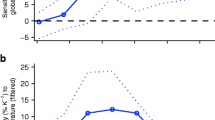Summary
The mutually interacting pressure wave and diabatic heating wave originally cause the observed tropical disturbances. The equivalent barotropic models relate the tendency of vorticity with the convective heating effect directly, and so these models elucidate the roles of these mutually interacting waves on the development of observed tropical disturbances readily. The exact solution for the complex frequency adequately explains the growth and movement of tropical disturbances during summer. The results are divided into two parts 1) for the upper atmosphere 2) for the lower atmosphere. For the upper atmosphere during summer, the standing and amplifying natures of wave numbers 1 and 2 are satisfactorily interpreted. So the standing natures and the intensity variations of Atlantic trough, African high, Tibetan high, Pacific trough, and Mexican high etc. are also explained thereby. Also, the amplification and westward movement of short wave number 8 are interpreted. For the lower atmosphere during summer, the amplifications and westward movements of Carribean easterly wave, African monsoon cyclone, Indian monsoon depression, west Pacific ITCZ wave etc. are explained.
Zusammenfassung
Die sich gegenseitig beeinflussende Druckwelle und diabatische Erwärmungswelle verursachen ursprünglich die beobachteten tropischen Störungen. Die äquivalentbarotropen Modelle verbinden die Vorticity-Tendenz mit dem konvektiven Erwärmungseffekt direkt, und damit erklären diése Modelle die Bedeutung dieser sich gegenseitig beeinflussenden Wellen für die Entwicklung der beobachteten tropischen Störungen. Die exakte Lösung für den Häufigkeitskomplex erklärt hinreichend die Entwicklung und die Bewegung tropischer Störungen im Sommer.
Die Ergebnisse werden in solche für die obere Atmosphäre und für die untere Atmosphäre unterteilt. Für die obere Atmosphäre im Sommer sind die beständigen und sich verstärkenden Formen der Wellenzahl 1 und 2 befriedigend interpretiert. Damit sind auch die beständigen Formen und die Intensitätsänderungen des atlantischen Troges, des afrikanischen Hochs, des tibetischen Hochs, des pazifischen Troges und des mexikanischen Hochs erklärt. Auch die Verstärkung und Westwärtsbewegung der kurzen Wellenzahl 8 sind erklärt. Für die untere Atmosphäre im Sommer sind die Verstärkung und Westwärtsbewegung der karibischen östlichen Welle, der afrikanischen Monsun-Zyklone, der indischen Monsun-Depression, der westpazifischen ITCZ-Welle und der zentralpazifischen ITCZ-Welle erklärt.
Similar content being viewed by others
References
Charney, J. G.: The Dynamics of Long Waves in a Baroclinic Westerly Current. J. Met.4, 135 (1947).
Eady, E. T.: Long Waves and Cyclone Waves. Tellus1, 33 (1949).
Charney, J. G., Stern, M. E.: On the Stability of Internal Baroclinic Jets in a Rotating Atmosphere. J. Atmos. Sci.19, 159 (1962).
Pedlosky, J.: The Stability of Currents in the Atmosphere and Ocean: Part I. J. Atmos. Sci.21, 201 (1964).
Miles, J. W.: Baroclinic Instability of the Zonal Wind. Rev. Geophys.2, 155 (1964).
Green, J. S. A.: A Problem in Baroclinic Instability. Quart. J. R. Met. Soc.86, 237 (1969).
Charney, J. G., Eliassen, A.: On the Growth of the Hurricane Depression. J. Atmos. Sci.21, 68 (1964).
Kuo, H. L.: On the Formation and Intensification of Tropical Cyclones Trough Latent Heat Release by Cumulus Convection. J. Atmos. Sci.22, 40 (1965).
Yamasaki, M.: Large-Scale Disturbances in the Conditionally Unstable Atmosphere in Low Latitudes. Papers Met. Geophys.20, 289 (1969).
Ooyama, K.: Numerical Simulation of the Life Cycle of Tropical Cyclones. J. Atmos. Sci.26, 3 (1963).
Mahanti, A. C.: The Study of the Instability of the Meridional Flow: Part 1. Arch. Met. Geoph. Biokl., Ser. A29, 235 (1980).
Mahanti, A. C.: The Stability of Monsoon Depression. Arch. Met. Geoph. Biokl., Ser. A30, 39–53 (1981).
Krishnamurti, T. N.: Lectures on Tropical Meteorology. FSU Report No. 75-8. Florida State University, 1975.
Holton, R. J.: An Introduction to Dynamic Meteorology. New York and London: Academic Press. 1979.
Mahanti, A. C.: The Study of the Instability of the Meridional Flow: Part 2 Arch. Met. Geoph. Biokl., Ser. A30, 23–38 (1981).
Krishnamurti, T. N.: Observational Study of the Tropical Upper Tropospheric Motion Field During the Northern Hemisphere Summer. J. Appl. Met.10, 1053 (1971).
Flohn, H.: Contributions to a Meteorology of the Tibetan Highlands. Report No. 130, Colorado State University, Fort Collins, 120 pages.
Krishnamurti, T. N., Kanamitsu, M.: A Study of the Coasting Easterly Wave. Tellus25, 568 (1973).
Tripoli, G. J., Krishnamurti, T. N.: Low Level Flows over the GATE Area During Summer. Mon. Weath. Rev.103, 197 (1972).
Nitta, T., Yanai, M.: A Note on the Barotropic Instability of the Tropical Easterly Current. J. Met. Soc. Japan47, 127 (1969).
Kuo, H. L.: Dynamic Instability of Two-Dimensional Non-Divergent Flow in a Barotropic Atmosphere. J. Met.6, 105 (1949).
Krishnamurti, T. N., Kanamitsu, M., Godbole, R., Chang, C., Carr, F., Chow, J.: A Study of a Monsoon Depression I. Synoptic Structure. J. Met. Soc. Japan53, 227 (1975).
Krishnamurti, T. N., Kanamitsu, M., Godbole, R., Chang, C., Carr, F., Chow, J.: Study of a Monsoon Depression (ii), Dynamic Structure54, 208 (1976).
Author information
Authors and Affiliations
Additional information
1 Figure
Rights and permissions
About this article
Cite this article
Mahanti, A.C. The origin of tropical disturbances. Arch. Met. Geoph. Biocl. A. 30, 167–183 (1981). https://doi.org/10.1007/BF02257841
Received:
Issue Date:
DOI: https://doi.org/10.1007/BF02257841




